This was published 7 years ago
Abdul’s brother went out to buy flour. He never came home
In the barracks of Australia’s most elite fighting unit, the incident is discussed in hushed tones.
By Nick McKenzie & Chris Masters
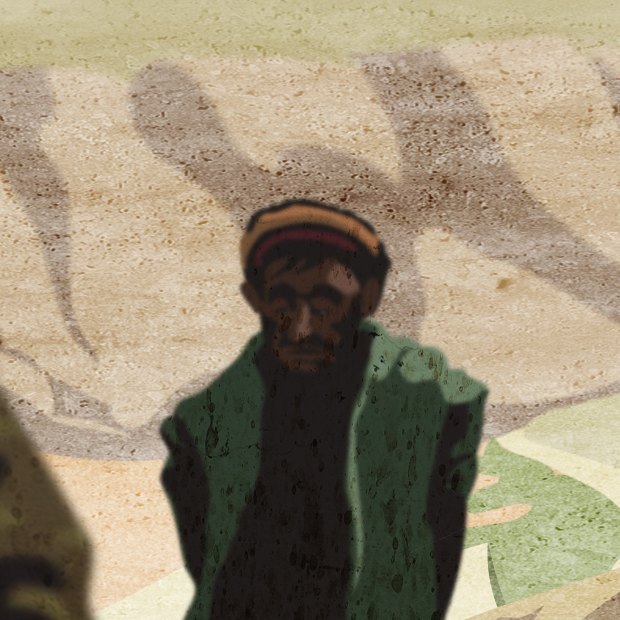
A special forces soldier and his prisoner in Darwan, Afghanistan. Illustration by Matt Davidson based on witness account.
The Australian special forces soldier led his prisoner towards a ridge above a dry creek bed near the Afghan village of Darwan.
The prisoner’s fate lay in the hands of the man leading him to the edge. His own hands were bound.
It was September 11, 2012 – 11 years to the day after planes piloted by al-Qaeda ploughed into the World Trade Centre, causing Australia to enter what would become the nation’s longest war.
The handcuffed detainee was Ali Jan, a shepherd in his late 30s from a village three hours walk from Darwan where his wife’s family owned a plot of land.
The day before, he’d travelled by donkey to Darwan to get flour. He’d left his pregnant wife, Bibi, and seven young children behind, telling them he’d be back soon.
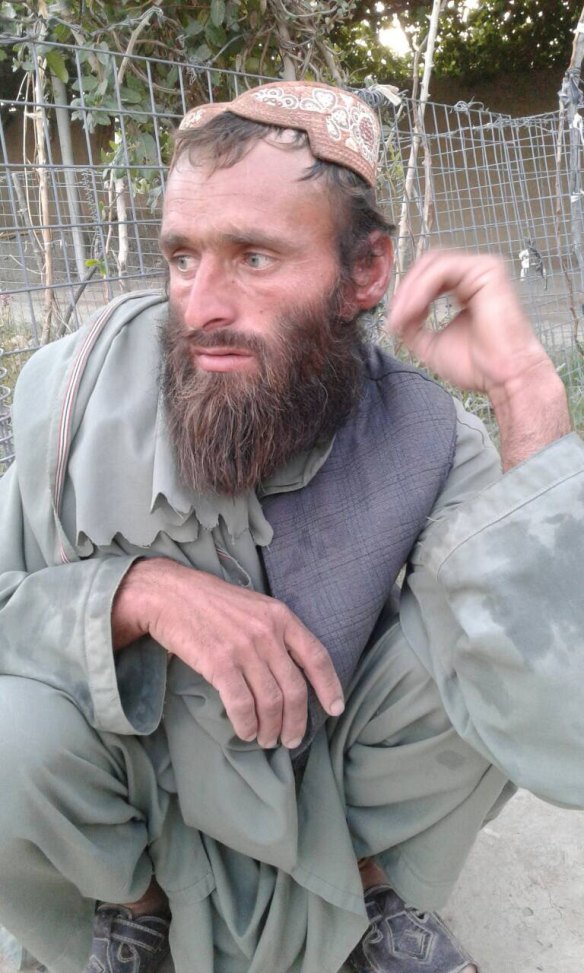
Abdul Ahmad, the brother of Ali Jan, tells his brother's story.
After arriving in Darwan, Ali Jan had dinner and settled in for the night at a relative’s home, a bare mud house brightened with carpets and the chatter of children. He planned to return home the next morning.
But when the sun rose on what was to be the last day of Ali Jan’s life, it revealed a group of heavily armed Australian soldiers sweeping through Darwan on a manhunt.
They were searching for a rogue Afghan National Army sergeant called Hekmatullah who, days earlier, shot dead three unarmed and unsuspecting diggers and injured two others as they played cards inside a coalition patrol base.
By the time the Australian special forces soldiers arrived in Darwan, the wanted man had vanished. Hoping to find any trace of his whereabouts, they began arresting dozens of local men for questioning. At some point, Ali Jan was also detained.
Most of the men were later released, but Ali Jan never arrived home. Soon, word reached his wife that something terrible had happened at Darwan.

Hekmatullah posted by the Taliban on Twitter in 2012.
Since then, speculation about what happened in that village in the rugged hills of Afghanistan’s central Oruzgan province has only intensified, travelling across continents and time zones. In the Perth barracks of Australia’s most elite fighting unit, the Special Air Services Regiment, the incident is discussed in hushed tones. In southern Afghanistan it evokes grief.
Now, five years after Ali Jan was walked towards the cliff edge, rumour has hardened into allegations, and then into evidence. Fairfax Media has spent months looking into Ali Jan’s fate as part of broader investigation into the behaviour of SASR forces in Afghanistan. The investigation involved interviews with dozens of current and former soldiers and senior officials, and unearthed highly confidential documents and briefings. Fairfax Media also hired an Afghan journalist to track down Darwan villagers and Ali Jan's’s family to tell their story.
Among the special forces soldiers risking their careers to brief Fairfax reporters are those who have also been summoned to give evidence to a special inquiry now being held into the actions of Australians in Afghanistan. This inquiry is run by a Supreme Court judge with the backing of top military officials.
Behind closed doors, the words “war crimes” are being used. Not only specific incidents, but the entire culture and command structure of Australia’s most renowned and trusted fighting force is now under scrutiny in a manner unprecedented in Australian military history.
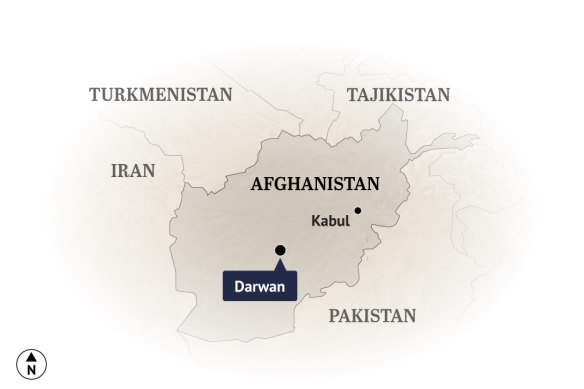
The village of Darwan in Afghanistan.Credit: Fairfax
Sotto voce: the quiet voice
In May 2015, as the colder nights advanced on Canberra, a newly minted Special Operations Commander issued a memo.
It had been 18 months since the Special Operations Task Group, comprised principally of the SAS Regiment and its younger special forces siblings, the Sydney-headquartered Commandos, had withdrawn from Australia’s longest war. During 13 years on the battleground in Afghanistan, the SASR had sent 23 rotations involving thousands of men and hundreds of missions. Many of the 41 Australians killed in Afghanistan served with these two elite forces.
Major General Jeff Sengelman, an intense and cerebral officer known for speaking his mind, began his report by describing three concerning incidents: an SASR member had been caught stealing explosives, another had been arrested for armed robbery, and a third had lost weapons. Sources say a fourth incident, which involved a SASR soldier drawing a pistol on an Australian spy in Afghanistan, had also deeply troubled Sengelman.
These incidents, wrote the new commander, were symptoms of something deeper and more worrying: a “gradual erosion of leadership and accountability across the full span of command responsibilities”.
Then he switched to plainer language. He was worried, he said, that the nation’s most revered group of soldiers was “no longer holding itself to account”.
Sengelman urged SASR members to write to him personally about their concerns. It was a bold move.
Tracing its beginnings back to the top-secret Australian Z Special Unit that fought during World War II and operating under the motto "Who Dares Wins", those in the regiment receive intensive training to carry out the nation's most sensitive and dangerous military missions.
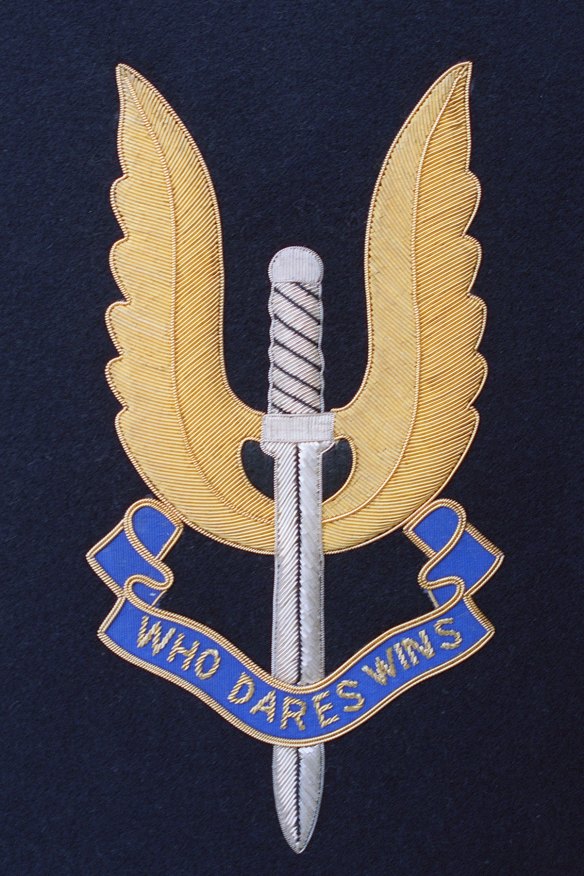
The SAS logo: Who Dares WinsCredit: Ken Irwin
As the SASR has adapted to modern conflict, hunting terrorists in Iraq and Afghanistan and leading spy missions in Africa, its historical penchant for secrecy has remain unchanged. Everything is classified until it is not.
The 700-odd members – half of whom are active “operators” who must pass a gruelling selection course testing their physical and mental capacity – cannot be photographed or discuss their work, ostensibly for operational and national security reasons.
They are men used to anonymity, and who tend to resent anyone, including one of their own, breaking ranks.
"They love the mystique,” is how one special forces insider described it in a leaked defence report charting the special forces’ culture, “and the government loves it. And everybody loves it”.
It wasn’t just this culture that Sengelman was challenging, but also a bond of brotherhood, forged at its deepest in blood and bravery. Historian Charles Bean describes Australia’s “big” discovery in WWI – the “character of men” – as forged by the ANZACs who “rushed the hills at Gallipoli and held out there during the long afternoon and night”.
I’m all for dropping the hammer when the time comes. But that doesn’t mean killing civilians or getting up your ‘kill count’.
A highly decorated SASR veteran
The SASR’s character and place in Australia is shaped by its own stories. Most recently, certain battles in Afghanistan have helped define the regiment: the courageous fight at Tizak in 2010, which involved many SASR soldiers displaying extraordinary heroism under fire; and the bravery displayed during a fierce firefight with the Taliban in 2008 at Khas Oruzgan. Both battles led to multiple awards being presented to SASR members, including two Victoria Crosses, the Commonwealth’s highest honour.
But in spite of this fierce pride and the taboo about breaking ranks, members began writing to Sengelman. Over time, serving and former regiment members have also briefed reporters working on this story. They speak of an untold story from Afghanistan involving a small number of regiment members who began to confuse secrecy with impunity; men whose actions exist in the shadowy margins of what constitutes proper behaviour in combat.
As one highly decorated Afghanistan SASR veteran puts it: “I’m all for dropping the hammer [shooting people] when the time comes. But that doesn’t mean killing civilians or getting up your ‘kill count’ when you can take a prisoner instead.”
Says another who fought at Tizak: “I’ve got no problem with taking out bad fellas. But what happened at Darwan and elsewhere isn’t right.”
As the letter count grew, Sengelman called his boss, then Chief of Army Angus Campbell, himself a former SASR officer. Together, they commissioned a defence consultant, Dr Samantha Crompvoets, to dig further.
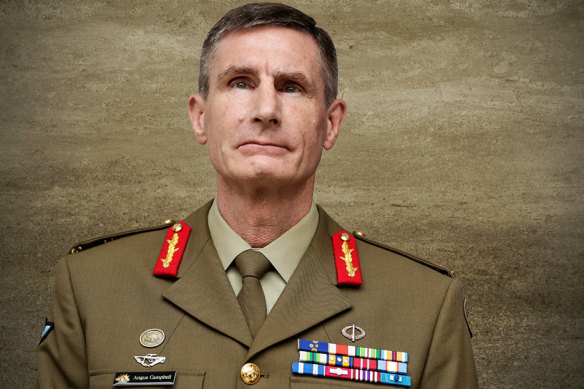
Army chief Angus Campbell. Credit: Alex Ellinghausen
Crompvoets was given free rein. She spoke to people from the Chief of Defence Force downwards in preparing her highly confidential 2016 report, which Fairfax Media has seen. Crompvoets wrote of SASR “insiders” initially disclosing information "sotto voce" or in the quiet voice. Over time, she wrote, these insiders got “much louder … and difficult to ignore” as they spoke of “extremely serious breaches of accountability and trust”.
At their most serious, Crompvoets wrote, their accounts concerned the “unsanctioned and illegal application of violence on operations, disregard for human life and dignity, and the perception of a complete lack of accountability”.
Crompvoets’ report reinforced a fear held by some in Perth that the SASR’s character had been compromised by a small group inside the regiment.
Crompvoets, Sengelman and Campbell all declined to be interviewed. But by the end of 2016, all three were acutely aware that one SASR soldier was being whispered about more than most. He had deployed repeatedly to Afghanistan and formed impeccable connections up the chain of command.
One SASR officer, to himself, called this man "Leonidas", after a fearsome warrior of ancient Sparta. Leonidas was part of the sweep through Darwan on September 11, 2012. And it was Leonidas who had allegedly led Ali Jan to the edge.
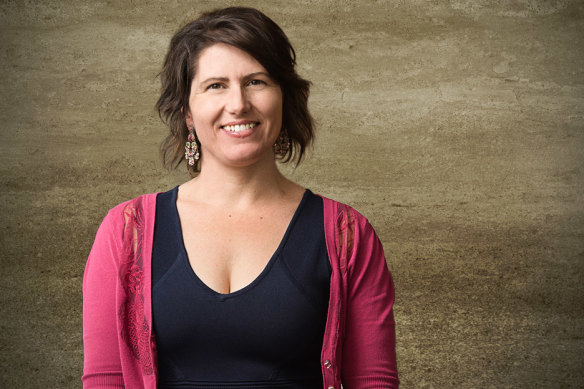
Defence consultant Dr Samantha Crompvoets.Credit: Fairfax and theroadhome.com.au
Sparta and Hollywood
Questions inside the regiment about Leonidas, who Fairfax Media unsuccessfully sought to interview and who cannot be named for legal reasons, began to be asked in 2009. At the time, he was part of an SASR patrol that was increasingly dividing the regiment. A warrior culture was being embraced by some special forces troops but loathed by others. It involved tattoos and a devotion to the Hollywood movie 300, which glorifies the fighting prowess of the ancient Spartans, and whose climactic moment involves an enemy soldier being kicked off a precipice.
Several former SASR officers say this rock-star ethos emboldened certain soldiers to test the elasticity of the rules of engagement – rules that govern when a soldier can take a life.
“The Regiment over time prided itself on being an organisation that broke the rules but not the law,” explains one former officer. “What happened, though, was during the Afghan campaign, there was a group of individuals who believed they were immune from the law.”
A specialist embedded with the SASR noted two distinct personalities emerging as one four-month rotation blurred into the next and the regiment honed its ability to kill or capture militants, men placed on the coalition’s Joint Priority Effects List, the modern version of a wanted poster.
The specialist says some soldiers sought redeployment in Afghanistan because they loved the hunt. Others came to feel uneasy as an escalating enemy body count was not matched by progress in achieving the US-led NATO mission.
Former SASR captain Andrew Hastie, who served in Afghanistan in 2013 and is now a Liberal MP, recalls the latter group of soldiers “grasping for operational clarity in a fog of strategic ambiguity”.
The patrol Leonidas belonged to appeared unburdened by such introspection. In this group, sources say, junior members were pushed to kill rather than detain.
In time, members of this patrol tacked a “kill board” to the wall of their patrol room. Members of another patrol heard Leonidas urging his fellow patrol members on – “only two more to go, boys” – a suspected reference to reaching a desired kill count to record on the board.
Sources say the patrol fused a warrior ethos with the regiment’s secretive culture. Its aggressive approach drew some admirers, including officers who believed it was needed on Afghanistan's asymmetrical battlefield. Leonidas, too, had his fierce backers, including regiment members who believed his assertive soldiering was setting an example for others in the regiment. Those bagging Leonidas, they said, were jealous of his courage and resolve.
Less aggressive patrols risked unofficial sidelining. One patrol commander was regarded by his peers as overly cautious after he told his soldiers they had to be comfortable with everything they did in battle.
“He told us we needed to be able to get to sleep at night when we were grandparents,” says a patrol member. Subsequently, this member says the patrol started being overlooked for missions.

Former SASR captain, MP Andrew Hastie. Credit: Alex Ellinghausen
Rumblings and discontent
By 2010, there were disparate rumblings about incidents involving Leonidas’ patrol on the battlefield. A prisoner of war was found dead in suspicious circumstances by a member of another patrol; an SASR soldier discovered the bodies of two farmers in a field without weapons; one of Leonidas’ patrol colleagues was quietly complaining about another shooting on patrol.
In each case, Leonidas’ patrol had failed to conduct a proper “site sensitive exploration”, according to sources at the scenes.
This is supposed to involve scouring for any items that can be exploited for intelligence, such as radios, but it also helps document the circumstances of a killing, such as whether a person was armed.
But it was not until two years later, in 2012, that witnesses began emerging with vivid, first-hand testimony about what Samantha Crompvoets later described as “unsanctioned and illegal application of violence”.
Journalist Chris Masters on "kill counts"
By the second-last year of Australia’s deployment, the coalition’s Afghanistan strategy was on life support. Soldiers and diplomats viewed Afghanistan’s criminal justice system as a revolving door for militants. According to a former SASR officer, small, combat-fatigued cliques inside the regiment were embracing “special warrior” rules of combat. They were enabled, he says, by wilfully blind colleagues and an embattled command system.
Then, on August 29, 2012, Afghan sergeant Hekmatullah shot dead three Australian soldiers.
The murdered trio were meant to be Hekmatullah’s comrades, but he killed them in cold blood and fled. One defence insider embedded with the SASR, as it began the hunt for Hekmatullah, describes a “change of attitude, a change of eyes”. Some soldiers, he says, were out for blood.
When satellites intercepting phone calls gathered intelligence that placed Hekmatullah in the vicinity of Darwan, the Australians moved fast. For them, he was the most wanted man in Afghanistan.
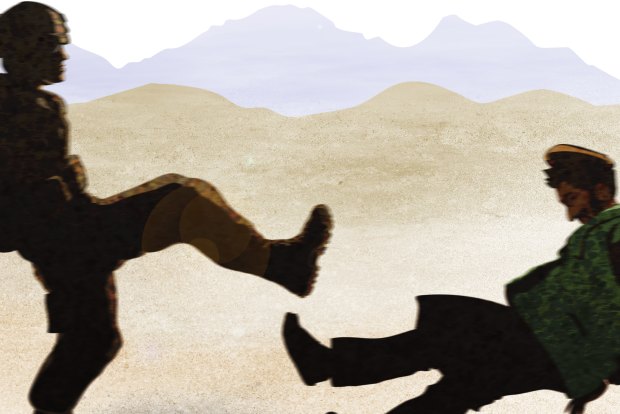
A special forces soldier kicks an Afghan prisoner.Credit: Illustration by Matt Davidson based on eyewitness account.
'One spotter K-I-A'
The radio message crackled into the earpieces of the special forces soldiers: “Three minutes ‘til wheels up.” The Darwan mission was ending. The helicopters were about to take the Australians and a small number of villagers selected for additional questioning back to the district capital, Tarin Kowt.
Soon after, the 50 or so detainees crammed into a compound at Darwan received their own blunt warning. “If you come outside before the helicopters are gone, you’ll be shot,” an SASR patrol commander barked.
The Afghans waited, some with heads bowed, listening for the whir of rotor blades that would signal the end of their ordeal.
Then the radio crackled again, this time relaying a message from Leonidas: “One spotter K-I-A [killed in action],” he said.
One of the SASR members on the ground, a respected and experienced operator, describes feeling a distinct pang of suspicion. “I thought to myself, something’s not right.”
The SASR had already spent hours searching compounds and rounding up dozens of men, designated “PUCs” (Persons Under Confinement) so they could be interrogated.
The soldier who felt something was awry was a member of a six-man patrol with a clear line of sight up the dry creek bed, but at a distance of about 50 metres from detainees being guarded by a patrol that included Leonidas. If a spotter – an enemy surveillance operative who reports coalition soldiers’ movements to militants – had emerged, the soldier reckoned he would have seen him. It also made little sense, the soldier thought, for an active spotter to approach the Australians so late into their Darwan mission.
“We didn’t require any spotting – we had come in like an elephant and made our presence well known,” the SASR soldier recalls.
As his helicopter lifted off, he remembers glancing down from a helicopter, seeing what looked like a body at the bottom of a cliff and asking himself a question: if it wasn’t a spotter who was K-I-A, who was it?
Some time later, an SASR soldier responsible for securing the Darwan detainees separately approached two senior regiment members with an answer. The junior soldier described a scene he’d witnessed which was playing on an endless loop in his head, haunting his dreams. It involved an irate and frustrated Leonidas grabbing one of the handcuffed PUCs and walking him to the edge of a rocky cliff perhaps 10 metres high.
Leonidas gave himself a short run-up then kicked the detainee off the edge. As he plunged, his face smashed into rocks. Then the injured man was executed, the junior soldier told his two superiors.
A second witness serving with the SASR during the Darwan mission has corroborated that story. He says he saw Leonidas kicking “the hell” out of an Afghan detainee, causing him to tumble down the rocky incline. This witness says this incident mirrored the climactic “kick” scene from the Sparta movie, 300.
As the PUC lay injured, hands still bound, this second witness says Leonidas conferred with a small number of soldiers, explaining the injured prisoner “was acting suspicious”. Then the man, says this witness, was summarily executed in some scrub out of the view of the other detainees and most of the other soldiers.
Stories differ about the precise sequence of events leading to the fatal bullet being fired, although both witnesses say Leonidas was party to the decision to “get him [the PUC] out of his misery”.
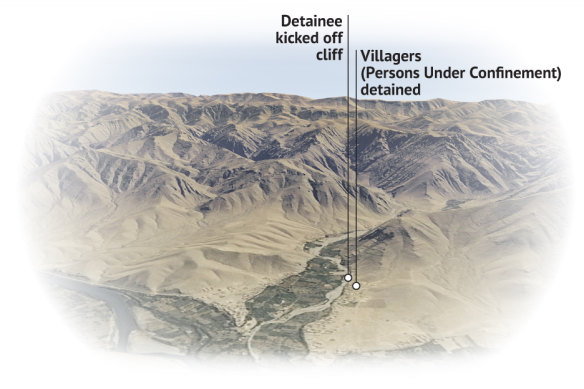
Darwan and the place where the prisoner was attacked.Credit: Fairfax, Google Maps
Villagers tracked down by an Afghan journalist working with Fairfax Media provide further corroboration. Darwan's village elders claim that several innocent residents were slain when the SASR swept through the village on September 11, 2012. Among their tally of the dead were two men killed in a compound filled with almonds. These two deaths match reports filed by SASR members save for a critical difference: the soldiers say the two men were armed, the villagers say they were not.
The villagers also describe a detainee who was forced over a cliff by an Australian soldier and then executed.
When the soldiers had flown away, the villagers recognised the dead man as Ali Jan, a shepherd from a nearby village. They dispatched a young boy to run to a village three hours away with the news. Expecting her husband to return home to the hills with flour and gossip from the village, Ali Jan’s pregnant wife, Bibi, instead received word that he was dead.
Ali Jan's brother, Abdul Ahmad, was with her. He recalls reeling in disbelief that "a person who went to get flour" could somehow end up dead. When the news sunk in, it brought utter despair.
"Then the screams started," Ahmad says.
"Ali Jan's mother was crying day and night for a week. His two elder daughters were screaming and running after their grandmother'' in a state of bewilderment, pleading to be told their father was alive.

A body was seen from a helicopter near the village of Darwan. Illustration by Matt Davidson based on witness account.
A secret hearing
In late 2017, a SASR soldier who had been at Darwan received an unexpected call from a defence investigator working for NSW Supreme Court judge Paul Brereton. Justice Brereton, the investigator explained, wanted the soldier to attend a secret hearing.
Several weeks later, another SASR member was summoned for questioning. This year, many more have been grilled.
In 2016, and partly as a result of the Crompvoets inquiry, Justice Brereton was commissioned by the then Chief of Army, Angus Campbell, to investigate what the defence department described as “rumours” of special forces’ misconduct in Afghanistan.
Brereton refuses to be interviewed by the media, but those who know the 60-year-old judge describe him as determined and fiercely independent. He also has military credibility, having enjoyed a decorated career as an army reservist, including as a commander of the fifth brigade. His father, NSW judge Russell Brereton, prosecuted Japanese soldiers for war crimes after WWII.
Two soldiers who have been interviewed by Brereton say many of his questions were directed to events at Darwan.
“I was blown away by the detail he had,” says one interviewee.
Yet both soldiers, and several others who’ve been interviewed, say they are unsure if Brereton has the power and backing not only to breach the SASR code of silence but expose all that he finds.
Some senior defence officials insist Brereton’s inquiry, which operates under the aegis of the secretive watchdog, the Inspector General of Defence, is limited to a “scoping” exercise and that any credible evidence of war crimes will need to be referred to the Australian Federal Police for a subsequent inquiry.
In a statement, the defence force said the Brereton inquiry would make "recommendations" about how to deal with any substantiated allegations of war crimes.
"The IGADF Afghanistan Inquiry has, for some time, been aware of allegations of significant issues involving the Special Operations Task Group in Afghanistan, which are within the scope of the Inquiry," the statement said.
Senior federal police privately say they are wary of inheriting from Brereton a politically sensitive probe involving a cold evidence trail on a foreign battlefield.
And yet evidence is mounting. During research for this story, two first-hand witnesses provided detailed, corroboratory accounts of Leonidas’ directing an Afghan partner-force soldier to execute a prisoner of war in October 2012.
Evidence also extends beyond Leonidas and his collaborators, to a small number of other SASR members. This evidence points to other summary executions or attempts to cover up civilian deaths. While the allegations involve a tiny minority of the regiment, they also raise questions about the blindness and competency of some of their commanders.
The commandos – the other major component of Australian special forces – do not appear to be facing as serious allegations as those in SASR.
In her confidential report, Samantha Crompvoets warned the issues she had uncovered should not be dismissed as soldiers “blowing off steam”. Rather, she wrote, they involved “problems deeply embedded in the culture” of the special forces, which would resist “simple or cosmetic solutions”.
Crompvoets also warned of “a deep impediment to change because of the extent to which leaders with SOF [special operation forces’] backgrounds, highly placed throughout the ADO [defence] and beyond, were compromised by their own participation or complicity in problematic behaviours of the past”.
Yet it is also clear that some of those who are fighting behind the scenes for transparency are serving or former SASR members. Angus Campbell, who in April was selected to become the next Chief of the Defence Force, appears to be among them.
One of his last moves as Chief of Army has been to restrict soldiers from wearing clothing adorned with controversial symbols, such as death heads and Spartan warrior iconography. It was met with howls of resistance from many in Defence and some in the media.
Those inside the SASR pushing for greater accountability say the public must be told how a small group of soldiers could act with apparent impunity even as those up the chain of command were ostensibly overseeing them.
Such a public reckoning, they say, could also consider the damage wreaked by those few soldiers who allegedly cared more for adding to their tally of dead than the Afghans they’d been sent overseas to protect.
By many accounts, the coalition’s mission in Afghanistan failed. The Taliban now controls more than 10 of Afghanistan’s 407 districts, including the village of Darwan, and, according to US government figures, it is building its influence in many more.
The freelance reporter who recently tracked down Ali Jan’s family for Fairfax Media worked under the constant threat that the Taliban might uncover his activities. Using a network of tribal elders, the freelancer arranged for Ali Jan’s brother, Abdul Ahmad, to travel to a safe house to tell the family's story.
Ahmad said Ali Jan's death had left his wife, Bibi, struggling to put food on the table. They can no longer afford meat or to send the children to school.
But the family, he said, had also been blessed. Three months after Ali Jan was allegedly kicked off a cliff by an Australian soldier, Bibi gave birth to a baby girl. Ali Jan's youngest daughter, Razia, is now five.
Reporting in Afghanistan by Sharif Khoram. Got a tip? Contact the reporters on this encrypted, secure and anonymous online platform